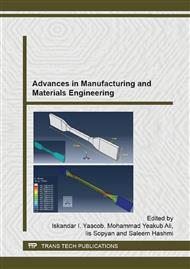p.585
p.589
p.596
p.601
p.606
p.610
p.616
p.622
p.627
Development of Design Structure Matrix of Product Architecture Case Study: Multi Purpose CNC Router
Abstract:
In developing any engineering product, it is crucial to develop product architecture of the system. An engineering team who responsible in developing different module should work together in order to obtain product architecture as a blueprint of the project. It is common to breakdown system or product into smaller elements as follows: subsystems, modules and component and define the interactions between components and subsystems. In order to achieve the performance of the system as a whole, these elements must be integrated to work together. One of the method to develop product architecture is Design Structure Matrix (DSM). The use of DSM for Development of Product architecture with case study a CNC router platform is presented. Using DSM, order of product development can be optimized and any form of wastes can be eliminated in the design stage.
Info:
Periodical:
Pages:
606-609
Citation:
Online since:
July 2015
Keywords:
Price:
Сopyright:
© 2015 Trans Tech Publications Ltd. All Rights Reserved
Share:
Citation:


